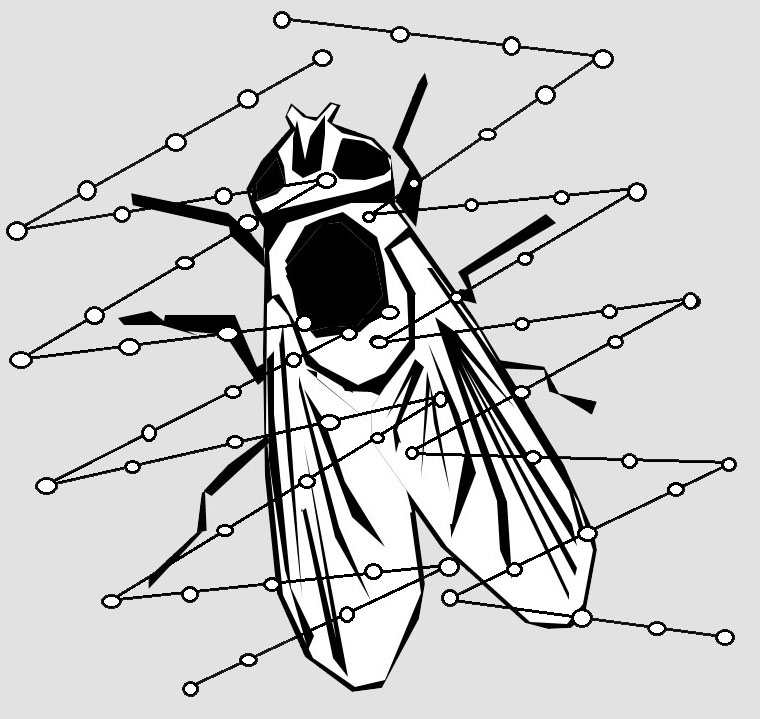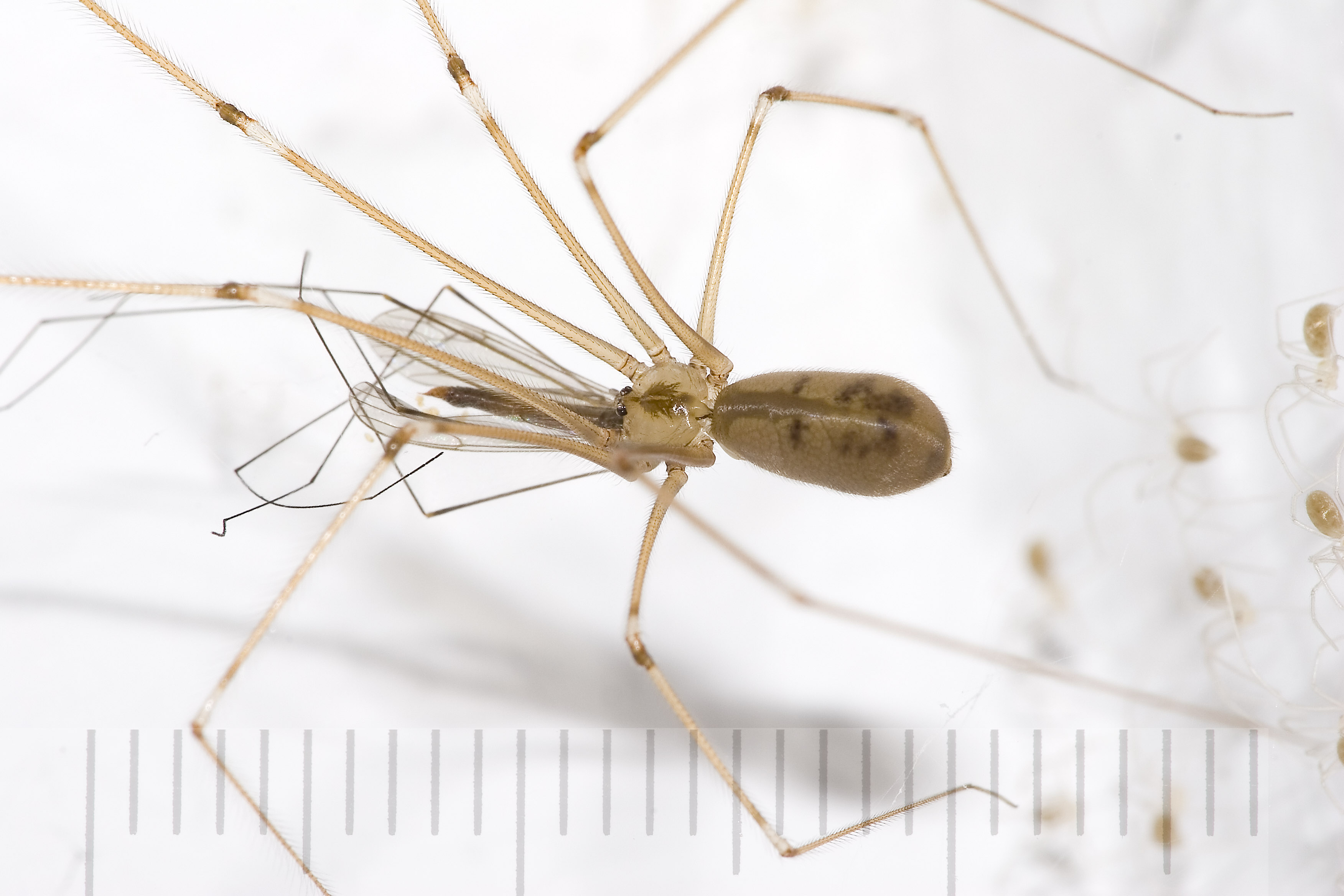|
Scytodidae
Spitting spiders (Scytodidae) is a family of araneomorph spiders first described by John Blackwall in 1864. It contains over 250 species in five genera, of which ''Scytodes'' is the best-known. Description Like recluse spiders and coneweb spiders, they have six eyes arranged in three pairs and are haplogyne, meaning they have less complex female genitalia. They differ from these families in having a dome-shaped carapace and in their characteristic flecked pattern of spots. Hunting technique Scytodidae catch their prey by spitting a fluid that congeals on contact into a venomous and sticky mass. The fluid contains both venom and spider silk in liquid form, though it is produced in venom glands in the chelicerae. The venom-laced silk both immobilizes and envenoms prey such as silverfish. In high-speed footage the spiders can be observed swaying from side to side as they "spit", catching the prey in a criss-crossed "Z" pattern; it is criss-crossed because each of the chelicerae e ... [...More Info...] [...Related Items...] OR: [Wikipedia] [Google] [Baidu] |
Scytodes
''Scytodes'' is a genus of spitting spiders that occur all around the world. The most widely distributed species is ''Scytodes thoracica'', which originally had a palearctic distribution, but has been introduced to North America, Argentina, India, Australia, and New Zealand. The genus was first described by Pierre André Latreille in 1804. Spitting spiders have pale yellow bodies with black spots on their cephalothorax, and legs that are characterized by black bands. Behavior Reproduction Spitting spiders are typically solitary until mating or hunting due to their aggressive nature. Males are cautious when trying to find a mate. Females carry their eggs until they hatch, typically under their body or in their chelicerae. This is the most vulnerable stage in life, the egg-carrying period. Upon hatching, the juvenile spiders remain in their mother's web. They cooperatively capture and feed on prey caught in the web. Upon reaching sexual maturity, the young spiders leave the web, ... [...More Info...] [...Related Items...] OR: [Wikipedia] [Google] [Baidu] |
List Of Scytodidae Species
This page lists all described species of the spider family Scytodidae accepted by the World Spider Catalog : ''Dictis'' ''Dictis'' L. Koch, 1872 * '' D. denticulata'' Dankittipakul & Singtripop, 2010 — Thailand * '' D. elongata'' Dankittipakul & Singtripop, 2010 — Thailand * '' D. ganeshi'' Keswani, 2015 — India * '' D. mumbaiensis'' Ahmed, Satam, Khalap & Mohan, 2015 — India * '' D. striatipes'' L. Koch, 1872 ( type) — Japan, Korea, China to Australia, French Polynesia * '' D. thailandica'' Dankittipakul & Singtripop, 2010 — Thailand ''Scyloxes'' ''Scyloxes'' Dunin, 1992 * '' S. asiatica'' Dunin, 1992 ( type) — Tajikistan ''Scytodes'' ''Scytodes'' Latreille, 1804 * '' S. adisi'' Rheims & Brescovit, 2009 — Brazil * '' S. aethiopica'' Simon, 1907 — Ethiopia * '' S. affinis'' Kulczyński, 1901 — Ethiopia * '' S. aharonii'' Strand, 1914 — Israel * '' S. akytaba'' Rheims & Brescovit, 2006 — Brazil * '' S. alayoi'' Alayón, 1977 — Mexico, Cuba * '' S. alb ... [...More Info...] [...Related Items...] OR: [Wikipedia] [Google] [Baidu] |
Stedocys
''Stedocys'' is a genus of Asian spitting spiders that was first described by H. Ono in 1995. Species it contains thirteen species, found in Asia: *'' Stedocys amamiensis'' Suguro, 2019 – Japan *'' Stedocys gaolingensis'' Wu & Li, 2017 – China *'' Stedocys huangniuensis'' Wu & Li, 2017 – China *'' Stedocys leopoldi'' (Giltay, 1935) – Malaysia, Thailand *'' Stedocys ludiyanensis'' Wu & Li, 2017 – China *'' Stedocys matuoensis'' Wu & Li, 2017 – China *'' Stedocys pagodas'' Labarque, Grismado, Ramírez, Yan & Griswold, 2009 – China *'' Stedocys pulianensis'' Wu & Li, 2017 – China *'' Stedocys shilinensis'' Wu & Li, 2017 – China *'' Stedocys uenorum'' Ono, 1995 ( type) – Thailand *'' Stedocys xiangzhouensis'' Wu & Li, 2017 – China *'' Stedocys xianrenensis'' Wu & Li, 2017 – China *'' Stedocys zhaoi'' Wu & Li, 2017 – Thailand See also * List of Scytodidae species This page lists all described species of the spider family Scytodidae accepted by the World S ... [...More Info...] [...Related Items...] OR: [Wikipedia] [Google] [Baidu] |
Soeuria
''Soeuria'' is a monotypic genus of Seychelloise spitting spiders containing the single species, ''Soeuria soeur''. It was first described by Michael I. Saaristo in 1997, and is found on the Seychelles. See also * List of Scytodidae species This page lists all described species of the spider family Scytodidae accepted by the World Spider Catalog : ''Dictis'' ''Dictis'' L. Koch, 1872 * '' D. denticulata'' Dankittipakul & Singtripop, 2010 — Thailand * '' D. elongata'' Dankittipaku ... References Monotypic Araneomorphae genera Scytodidae Spiders of Africa {{Araneomorphae-stub ... [...More Info...] [...Related Items...] OR: [Wikipedia] [Google] [Baidu] |
Scyloxes
''Scyloxes'' is a monotypic genus of Tajikistani spitting spiders containing the single species, ''Scyloxes asiatica''. It was first described by P. M. Dunin in 1992, and is found in Tajikistan. See also * List of Scytodidae species This page lists all described species of the spider family Scytodidae accepted by the World Spider Catalog : ''Dictis'' ''Dictis'' L. Koch, 1872 * '' D. denticulata'' Dankittipakul & Singtripop, 2010 — Thailand * '' D. elongata'' Dankittipaku ... References Monotypic Araneomorphae genera Scytodidae Spiders of Asia {{Araneomorphae-stub ... [...More Info...] [...Related Items...] OR: [Wikipedia] [Google] [Baidu] |
Dictis
''Dictis'' is a genus of Scytodidae, spitting spiders that was first described by Ludwig Carl Christian Koch in 1872. Species it contains four species, found in Asia, Oceania, North America and Seychelles: *''Dictis elongata'' Dankittipakul & Singtripop, 2010 – Thailand *''Dictis soeur'' (Saaristo, 1997) – Seychelles *''Dictis striatipes'' L. Koch, 1872 (Type_species, type) – Yemen, United Arab Emirates, Iran, tropical Asia, Korea, Japan, China to Australia, Pacific Isles. Introduced to USA, Mexico *''Dictis thailandica'' Dankittipakul & Singtripop, 2010 – Thailand See also * List of Scytodidae species References Araneomorphae genera Scytodidae Spiders of Asia Spiders of Australia Taxa named by Ludwig Carl Christian Koch {{Araneomorphae-stub ... [...More Info...] [...Related Items...] OR: [Wikipedia] [Google] [Baidu] |
Scytodes Thoracica
''Scytodes thoracica'' is a spitting spider, so called because it spits a venomous sticky silken substance over its prey. Its size ranges between . The carapace is unusual in sloping upwards towards its rear end, whereas the abdomen slopes downwards. It has six eyes instead of the eight spiders usually have. It has a wide distribution: found in "Europe, North Africa, Turkey, temperate Asia to China, Korea, Japan. Introduced to North America, Argentina, India, Australia, New Zealand." This particular spitting spider features the presence of silk glands in its cephalothorax. Besides the silk glands in its abdomen, the spider also has silk glands connected with its venom glands. In this way the spider has the ability to make venomous silk. Other Arachnida, arachnids may also have silk glands in their cephalothorax, such as the pseudoscorpions. Hunting tactics In contrast to the pseudoscorpions that use the silk from the cephalothorax glands to make nests, the spitting spider uses ... [...More Info...] [...Related Items...] OR: [Wikipedia] [Google] [Baidu] |
Diguetidae
Coneweb spiders (Diguetidae) are six-eyed haplogyne spiders that live in tangled space webs, fashioning a cone-like central retreat where they hide and lay eggs. It is a small family, containing only two genera with fifteen species and is confined to the New World, preferring deserts. Members of the genus '' Diguetia'' usually build their webs in shrubs or between cactus pads. They have the same eye arrangement as the venomous recluse spiders (family ''Sicariidae''), but none are known to be harmful to humans. Taxonomy The group was first created by F. O. Pickard-Cambridge in 1899 as the subfamily Diguetiinae of the family Scytodidae. It was raised to the rank of family by Willis J. Gertsch using the spelling "Diguetidae". Pickard-Cambridge's use of double "i" is correct according to Article 29.3 of the International Code of Zoological Nomenclature, since the name is based on the genus ''Diguetia''. In 2004, Jörg Wonderlich suggested reducing it again to a subfamily, this time ... [...More Info...] [...Related Items...] OR: [Wikipedia] [Google] [Baidu] |
Haplogyne
The Haplogynae or haplogynes are one of the two main groups into which araneomorph spiders have traditionally been divided, the other being the Entelegynae. Morphological phylogenetic studies suggested that the Haplogynae formed a clade; more recent molecular phylogenetic studies refute this, although many of the ecribellate haplogynes do appear to form a clade, Synspermiata. Unlike the Entelegynae, haplogynes lack hardened (sclerotized) female genitalia (epigynes). Most of the species within this group have six eyes, as opposed to most other spiders. Spiders in the genus '' Tetrablemma'' (Tetrablemmidae) have only four eyes, as do some members of the family Caponiidae; caponiids may even have only two eyes. However, spiders in the family Plectreuridae have the normal eight eyes. Phylogeny The Haplogynae are one of the two major groups into which araneomorph spiders were traditionally divided, the other being the Entelegynae. In 2005, Coddington summarized the relationships of ... [...More Info...] [...Related Items...] OR: [Wikipedia] [Google] [Baidu] |
Chelicerae
The chelicerae () are the mouthparts of the subphylum Chelicerata, an arthropod group that includes arachnids, horseshoe crabs, and sea spiders. Commonly referred to as "jaws", chelicerae may be shaped as either articulated fangs, or similarly to pincers. Some chelicerae, such as those found on nearly all spiders, are hollow and contain (or are connected to) venom glands, and are used to inject venom into prey or a perceived threat. In ''Pisaurina mira'', also known as the nursery web spider, the chelicerae are utilized to snatch the prey once it becomes within reach, facilitating the "sit-and-wait ambush predator" behavior. Both pseudoscorpions and harvestmen have structures on their chelicerae that are used for grooming (papillae in pseudoscorpions, cheliceral teeth in Opiliones). Types Chelicerae can be divided into three kinds: jackknife chelicerae, scissor chelicerae, and 3-segmented chelate chelicerae. Jackknife chelicerae The jackknife chelicera is subchelate (with ... [...More Info...] [...Related Items...] OR: [Wikipedia] [Google] [Baidu] |
Araneomorphae
The Araneomorphae (also called the Labidognatha) are an infraorder of spiders. They are distinguishable by chelicerae (fangs) that point diagonally forward and cross in a pinching action, in contrast to the Mygalomorphae (tarantulas and their close kin), where they point straight down. Araneomorphs comprise the vast majority of living spiders. Distinguishing characteristics Most spider species are Araneomorphae, which have fangs that face towards each other, increasing the orientations they can employ during prey capture. They have fewer book lungs (when present), and the females typically live one year. The Mygalomorphae have fangs that face towards the ground, and which are parallel to the long axis of the spider's body, thus they have only one orientation they can employ during prey capture. They have four pairs of book lungs, and the females often live many years. Image:Atrax robustus.jpg, This ''Atrax robustus'' shows the orientation of Myglamorphae fangs. Image:Che ... [...More Info...] [...Related Items...] OR: [Wikipedia] [Google] [Baidu] |
Species
In biology, a species is the basic unit of classification and a taxonomic rank of an organism, as well as a unit of biodiversity. A species is often defined as the largest group of organisms in which any two individuals of the appropriate sexes or mating types can produce fertile offspring, typically by sexual reproduction. Other ways of defining species include their karyotype, DNA sequence, morphology, behaviour or ecological niche. In addition, paleontologists use the concept of the chronospecies since fossil reproduction cannot be examined. The most recent rigorous estimate for the total number of species of eukaryotes is between 8 and 8.7 million. However, only about 14% of these had been described by 2011. All species (except viruses) are given a two-part name, a "binomial". The first part of a binomial is the genus to which the species belongs. The second part is called the specific name or the specific epithet (in botanical nomenclature, also sometimes i ... [...More Info...] [...Related Items...] OR: [Wikipedia] [Google] [Baidu] |





